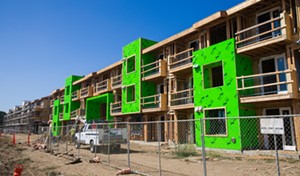The Santa Barbara County Planning Commission recently voted 4-1 (with 2nd District Commissioner Laura Bridley dissenting) to approve the county’s Housing Element update, which will go to the Board of Supervisors on Dec. 5.

The Housing Element is a process each jurisdiction in the state is required to go through every eight years to address housing needs and identify new housing development potential. The California Department of Housing and Community Development (HCD) wants Santa Barbara County to build 5,664 units in its unincorporated areas by the end of this cycle (2023-31) to meet the housing need—which is nearly 10 times larger than the previous cycle’s allocation of 661 units.
“We in this county are experiencing one of the nation’s most severe housing crises,” county Supervising Planner Allen Bell told the commissioners at the Nov. 8 meeting. “When we look at costs, the county ranks sixth in terms of the highest cost per rental housing in the U.S.”
Santa Barbara County is also expected to increase its population by 13 percent, from 461,000 in 2020 to 520,000 in 2050—increasing the demand for housing and continuing to put pressure on housing costs, he said.
The state divides the total housing development allocation into four income categories—very low, low, moderate, and above moderate, he said. This cycle, HCD also split Santa Barbara County’s allocation into two subsections, North County and the South Coast, with 75 percent of the allocation going toward the South Coast because of a jobs-housing imbalance.
North County must develop 1,522 new units—with 807 low- and very low-income units, 229 moderate income units, and 486 above moderate income units. Based on current vacant sites, accessory dwelling units, and pending projects, North County already has a surplus of moderate and above moderate units, but still needs to develop 478 units for low- to very low-income levels, according to the Planning and Development presentation.
The South Coast must develop 4,142 new units, 1,766 low- and very low-income, 1,051 moderate, and 1,325 above moderate—however it still needs to create space for 1,667 lower income and 860 moderate income units based on the current capacity.
The county can accommodate by rezoning private land or county-owned sites, planner Eva Marrero told commissioners.
“Staff examined more than 1,000 sites to identify an initial list of proposed rezones, vacant infill development sites for potential rezones that are closer to public transit, water, sewer, and other infrastructure,” Marrero said.
Planning and Development Director Lisa Plowman added that the state has 90 days to make the final determination after the Board of Supervisors hearings. Rezoning would be a separate process that will take place in early 2024.
“The state has gotten very serious about jurisdictions actually creating a set of circumstances where housing could be built,” Plowman said. “That means removing government barriers or other barriers we could control, making sure we have adequate land and adequate densities, and there are a lot of consequences when you’re not in compliance.”
If the county doesn’t approve the Housing Element, it could lose out on state grant funding for developments, lose local control and HCD would administer project permits rather than the county, or it could face state litigation, she said.
Despite the consequences, 2nd District Commissioner Bridley voted against the Housing Element in “a protest vote” because of the amount of housing allocated to her district alone.
“I have a district that is going to freak out when they understand what is going to be built near them or could be built near them,” Bridley said. “The 4,700 units that could happen in the 2nd District, for my constituent base that is not in the public welfare benefit or several of the findings. I know you will get approved. I think it was a good job, I’m just not there.”
She said that she’d like to see the housing spread out more between the districts rather than having it concentrated in the communities she represents.
“I understand better than other people the jobs-housing [imbalance], the work-to-home commute … but to have so much of it, 55 percent in the 2nd district, which is the smallest geographic district,” she said. “I just think that it’s a little bit lopsided, so spreading it out to other parts of the county, whether it’s a bit more in the 1st District or the 3rd District.”












